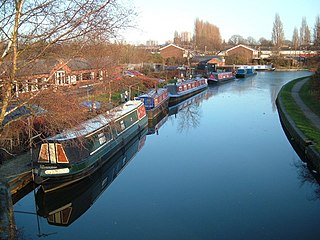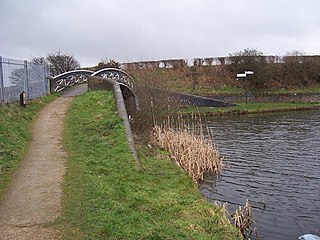Related Research Articles

The Wyrley and Essington Canal, known locally as "the Curly Wyrley", is a canal in the English Midlands. As built it ran from Wolverhampton to Huddlesford Junction near Lichfield, with a number of branches: some parts are currently derelict. Pending planned restoration to Huddlesford, the navigable mainline now terminates at Ogley Junction near Brownhills. In 2008 it was designated a Local Nature Reserve.

The Black Country is an area of England's Midlands. It is mainly urban, covering most of the Dudley, Sandwell and Walsall Metropolitan Boroughs, with the City of Wolverhampton sometimes included. The towns of Dudley and Tipton are generally considered to be the centre.

Cradley Heath is a town in the Metropolitan Borough of Sandwell, West Midlands, England. It is 2 miles (3 km) north-west of Halesowen, 3 miles (5 km) south of Dudley and 8 miles (13 km) west of Birmingham.

Foster, Rastrick and Company was one of the pioneering steam locomotive manufacturing companies of England. It was based in Stourbridge, Worcestershire, now West Midlands. James Foster, an ironmaster, and John Urpeth Rastrick, an engineer, became partners in 1816, forming the company in 1819. Rastrick was one of the judges at the Rainhill Trials in 1829. The company was dissolved on 20 June 1831.

Pelsall is a village and civil parish in the Metropolitan Borough of Walsall, West Midlands, England. Forming part of the borough's border with Staffordshire, Pelsall is located 4 miles north of Walsall, midway between the towns of Bloxwich and Brownhills and 4 miles northwest of Aldridge. The southern edge of Cannock Chase is 6 miles to the north. Pelsall is also 8 miles southwest of Lichfield and 8 miles northeast of Wolverhampton.

The Stourbridge Canal is a canal in the West Midlands of England. It links the Staffordshire and Worcestershire Canal with the Dudley Canal, and hence, via the Birmingham Canal Navigations, to Birmingham and the Black Country.

Pelsall railway station is a disused railway station that served the villages of Pelsall and Shelfield in the Metropolitan Borough of Walsall, West Midlands, England. It was on the South Staffordshire Line between Walsall and Lichfield.

Rushall is a suburb in the Metropolitan Borough of Walsall in the West Midlands, England. It is centred on the main road between Walsall and Lichfield. It is mentioned in the Domesday Book but has mostly developed since the 1920s. Rushall was historically a part of the county of Staffordshire before it was incorporated with much of the old Aldridge-Brownhills Urban District into the modern-day Walsall district.

Old Hill is a village in Rowley Regis in the metropolitan borough of Sandwell in the West Midlands, England, situated around 2 miles (3.2 km) north of Halesowen and 3 miles (4.8 km) south of Dudley. Initially a separate village it is now part of the much larger West Midlands conurbation.

The current Cannock Extension Canal is a 1.8-mile (2.9 km) canal in England. It runs from Pelsall Junction on the Wyrley and Essington Canal, north to Norton Canes Docks and forms part of the Birmingham Canal Navigations. Historically, it ran to Hednesford, and served a number of collieries, which provided the main traffic. It opened in 1863, and the northern section closed in 1963, as a result of mining subsidence.
The BCN Main Line, or Birmingham Canal Navigations Main Line is the evolving route of the Birmingham Canal between Birmingham and Wolverhampton in England.

Ogley Junction, on the Staffordshire county border near Brownhills, West Midlands, England, is a historic canal junction on the Wyrley and Essington Canal where the Anglesey Branch left the main line.

Pelsall Junction is a canal junction at the southern limit of the Cannock Extension Canal where it meets the Wyrley and Essington Canal main line, near Pelsall, West Midlands, England.

Rumer Hill Junction was a canal junction on the Cannock Extension Canal where the Churchbridge Branch left to join the Hatherton Canal. The junction, along with the northern section of the canal was abandoned in 1963. The Churchbridge Branch and Rumer Hill Junction were subsequently obliterated by opencast mining.

The Wednesbury Oak Loop, sometimes known as the Bradley Arm, is a canal in the West Midlands, England. It is part of the Birmingham Canal Navigations (BCN), and was originally part of James Brindley's main line, but became a loop when Thomas Telford's improvements of the 1830s bypassed it by the construction of the Coseley Tunnel. The south-eastern end of the loop was closed and in parts built over, following the designation of the entire loop as "abandoned" in 1954, including the section which was filled in at the beginning of the 1960s to make way for the Glebefields Estate in Tipton.

The Stourbridge Extension Canal was a short canal built to serve a number of mines in the Kingswinford area of Staffordshire in England. Although connected to the Stourbridge Canal, it was independent from it. It opened in 1840, and was abandoned in 1935. A short section of it is still used as moorings for boats using the Stourbridge Canal.

The River Sow Navigation was a short river navigation in Staffordshire, England, which connected the Staffordshire and Worcestershire Canal to the centre of Stafford. There was a coal wharf in Stafford, and a single lock to connect it to the canal. It opened in 1816, and closed in the 1920s. There are proposals to restore the navigation as the Stafford Riverway Link.

The Pensnett Canal, also called Lord Ward's Canal was a private 1.25 miles (2 km) long canal near Brierley Hill, West Midlands, England, which opened in 1840 and served the industrial enterprises of Lord Dudley's Estate. The engineer was Mathew Frost. Since its closure to navigation in 1950, much of it has been lost by overbuilding, but a small section at its junction with the Dudley Canal was restored in 1995, and the section through Brierley Hill remains in water, although it is polluted and not navigable.
John Bradley & Co was a company established in 1800 by John Bradley at Stourbridge in the West Midlands area of England. The company developed into a large industrial concern with furnaces, ironworks and mines. Under James Foster, John Bradley's half brother, it was instrumental in bringing the first commercial steam locomotive into the Midlands area in 1829. The firm stayed under family control until the early years of the 20th century when first the mining (1913) and then the ironworks (1919) were sold off. Part of the business continued to trade under the name John Bradley & Co. (Stourbridge) Ltd until after the Second World War.
The Walsall Silver Thread Tapestries are a set of eleven artworks, in the form of tapestries, designed by the artist Hunt Emerson in conjunction with the various communities of Walsall, England and hand stitched by local people there during 2016. They depict the people, places, history and wildlife of the towns and districts that, since 1974, have formed the Metropolitan Borough of Walsall.
References
- ↑ "Surname Database: Bloomer Last Name Origin". www.surnamedb.com.
- ↑ "Rowley village, Rowlley regis". rowleyvillage.webs.com.
- 1 2 3 4 5 "The Story of Walsall". www.historywebsite.co.uk.
- ↑ The London Gazette [ dead link ]
- 1 2 Pelsall History.com (Archived)
- ↑ "Pelsall in History". Archived from the original on 23 May 2014. Retrieved 2014-02-25.
- ↑ "Walsall Foreign Family History". Archived from the original on 14 July 2013. Retrieved 25 February 2014.
- ↑ The Birmingham Daily Post, Thursday, 22 May 1862, p.4, District News - Walsall Wood.
- ↑ Berrow's Worcestershire Journal - Thursday 6 March 1845, Worcestershire Sessions
- ↑ The Birmingham Daily Gazette, Wednesday, 2 August 1865, p.4, 'The Case of Manslaughter near Pelsall'
- ↑ The Birmingham Journal, Saturday, 15 April 1865 - 'Walsall'
- ↑ The Birmingham Daily Post, Thursday, 1 September 1864, District News, p.3
- ↑ The Paisley Herald and Renfrewnshire Advertiser, 1 August 1868, p.3, 'Advantages of Compulsory Education at the Ironworks
- ↑ "The Allens Register". allensregister.com.
- ↑ London Standard - Wednesday 24 September 1845, p.24, Railway Intelligence - 'South Staffordshire Junction Railway, Dudley'
- ↑ "Pelsall Hall 1872". www.ccmhs.co.uk.
- ↑ "Archived copy" (PDF). Archived from the original (PDF) on 1 April 2014. Retrieved 2014-02-25.
{{cite web}}: CS1 maint: archived copy as title (link) - ↑ "The day the boiler blew". BrownhillsBob's Brownhills Blog.
- ↑ The Sycamores, Church Road, Pelsall
- ↑ "Archived copy" (PDF). Archived from the original (PDF) on 2 March 2014. Retrieved 2014-02-27.
{{cite web}}: CS1 maint: archived copy as title (link) - ↑ "Pigot and Co.'s National Commercial Directory ...: Worcestershire". 1835.
- ↑ "Numerals and Letters in Connection with Articles of Commerce". The Yale Law Journal. January 1904.
- 1 2 "The London Gazette" (PDF). Archived from the original (PDF) on 1 March 2014. Retrieved 25 February 2014.